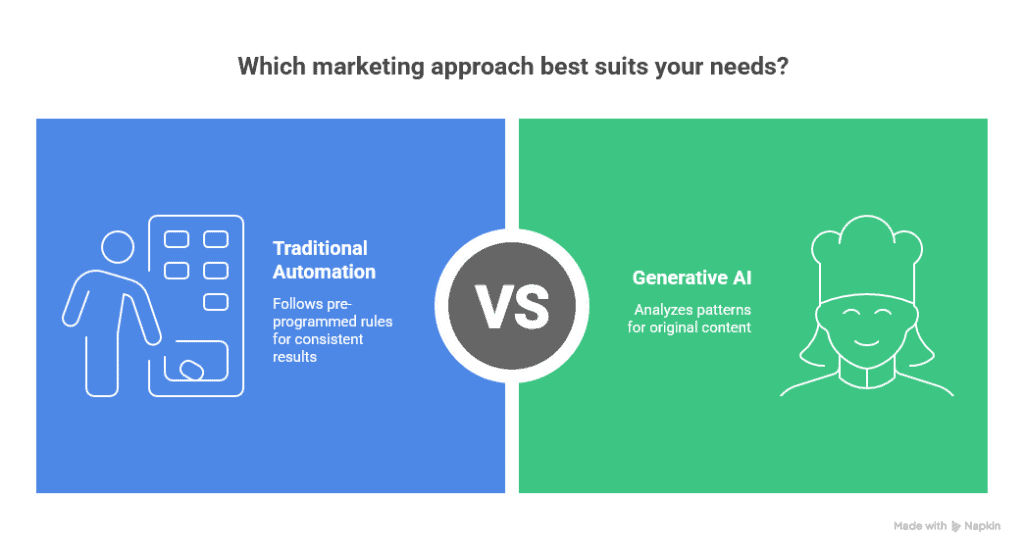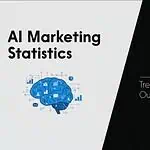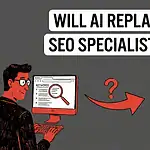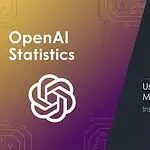You’ve probably noticed it by now. Your inbox is flooded with “AI-powered” marketing tools. Your boss is asking about ChatGPT integration. Your competitors are somehow churning out content at triple the speed they used to. And you’re stuck wondering: is this actually worth the hype, or just another tech fad that’ll fade in six months?
Here’s what you need to know. AI business usage jumped from 55% to 78% year-over-year, according to Stanford’s Human-Centered AI Index. That’s not a trend. That’s a shift. But here’s the thing, most marketers are either diving in blind or sitting on the sidelines overthinking it.
This guide cuts through the noise. We’re going to walk through what generative AI actually does for marketing, what it can’t do, which tools matter, and how to build a strategy that makes sense for your team. No fluff. No tech jargon. Just what you need to make smart decisions.
What Is Generative AI in Marketing?
Generative AI creates new content from scratch. You give it a prompt, and it generates original text, images, videos, or designs based on patterns it learned from massive datasets.
This is different from the marketing automation you’re already using. Your email platform segments audiences based on rules you set. Generative AI doesn’t follow pre-programmed rules. It analyzes patterns and produces something new each time.
Think of it this way. Traditional automation is like a vending machine. You press B3, you get the same candy bar every time. Generative AI is more like asking a chef to make you dinner. You say “something spicy with chicken,” and they create a dish based on what they know about cooking. The result is original, informed by training, but not identical to anything they’ve made before.
In marketing, this shows up everywhere. Content creation for blogs and social posts. Personalized email copy that adapts to individual customer data. Ad variations that test different angles. Image generation for campaigns. Even predictive analytics that help you spot trends before they peak.
The tool learns from data, identifies patterns, and generates outputs that match your goals. That’s the core of what makes it different, and what makes it useful when you know how to use it right.

Current State of Generative AI Adoption in Marketing
The numbers show a shift that’s impossible to ignore. Marketing teams are no longer just testing Gen AI. They’re integrating a generative AI strategy into their workflow.
Adoption Rates and Usage Patterns
Marketing departments rank among the top five functions using Gen AI across organizations. About 10% of all Gen AI initiatives happen in marketing – right behind IT and operations. That’s where content generation, brainstorming sessions, and personalization efforts are getting the biggest boost.
Here’s what that looks like in practice. Say you’re planning a campaign for a new product launch. Instead of spending three days drafting email variations, your team uses Gen AI to create 15 versions in an hour. You pick the best two, refine them, and test. The tool didn’t replace your judgment; it freed you to focus on strategy instead of grinding through drafts.
Over half of marketing teams now use AI to optimize content. Another 40% lean on it for research – gathering customer insights, analyzing competitors, or spotting trends. The pattern is clear: teams are moving from “let’s try this” to “this is part of our process.”
How Marketing Teams Measure ROI
The thing is, adoption means nothing without accountability. That’s why measurement matters.
According to Wharton research, 44% of marketing and sales departments actively track employee engagement and productivity tied to Gen AI. Another 48% measure profitability or losses directly linked to their AI investments.
What does that mean for you? If you’re using Gen AI, you need to track specific outcomes, not just usage. Are your content creation hours dropping? Is your email open rate climbing because subject lines are better tailored? Are you closing deals faster because sales collateral is more personalized?
Think of it this way. You wouldn’t buy new software without checking if it saves time or boosts revenue. Gen AI deserves the same scrutiny. The teams seeing real returns aren’t just using the tools; they’re measuring what changed because of them.
What’s Possible With Generative AI
Now that we’ve covered adoption and measurement, let’s get into the real stuff. What can Gen AI actually do for your marketing work?
Content Creation and Optimization
You can draft blog posts, email campaigns, and social media content in minutes instead of hours. Gen AI helps you test multiple headlines, adjust tone for different platforms, and rewrite copy for A/B testing. Say you need five variations of an ad for Facebook. Instead of manually writing each one, you feed the AI your core message, and it generates options you can refine. It also suggests SEO improvements by analyzing top-ranking content and identifying gaps in your existing pieces.
Personalization at Scale
According to Harvard DCE, Gen AI enables hyper-personalization across customer touchpoints. You can create unique email subject lines for different audience segments based on browsing behavior or past purchases. The tool analyzes customer data and adjusts messaging dynamically. For instance, someone who abandoned a cart gets a different message than a repeat buyer. You’re not manually writing hundreds of emails. The AI handles variations while you set the strategy.
Campaign Automation
You can automate ad placement, budget allocation, and even creative testing across channels. Gen AI monitors campaign performance in real time and suggests adjustments. If one ad set performs better on Instagram than LinkedIn, it reallocates spend automatically. It also generates landing page variations and tests them without you building each one from scratch. This cuts down the repetitive tasks that eat up your day.
Data Analysis and Insights
Gartner’s framework maps 20 use cases where Gen AI transforms data into actionable insights. You can ask the AI to summarize customer feedback from thousands of reviews, identify sentiment trends, or predict which products will spike in demand next quarter. It processes massive datasets faster than any human team. What used to take analysts days now happens in hours, giving you time to act on findings instead of just collecting them.
Customer Service Enhancement
You can deploy chatbots that handle common inquiries, freeing your team for complex issues. These bots don’t just follow scripts, they understand context and generate natural responses. A customer asks about return policies, and the bot pulls relevant info while matching your brand voice. It escalates to humans when needed, but handles routine questions 24/7. You’re improving response times without hiring more support staff.
What Generative AI Can’t Do
Here’s where things get real. Gen AI is powerful, but it’s not magic. Understanding its limits keeps you from making expensive mistakes.
Strategic Thinking and Brand Direction
Gen AI can’t decide your brand positioning or long-term marketing strategy. It processes patterns from existing data. It doesn’t create vision. When you’re choosing whether to target millennials or Gen Z, or deciding if your brand should pivot toward sustainability, that requires human judgment. The AI can show you market trends, but it can’t weigh company values, competitive dynamics, and future opportunities the way you can. Strategy needs context that goes beyond data.
Understanding Complex Context
The tool misses nuance. It doesn’t grasp cultural sensitivities, industry-specific jargon, or your company’s internal politics. You might ask it to draft a press release about a partnership, but it won’t know that the partner’s CEO has a history with your CEO that affects tone. It also struggles with sarcasm, humor, and regional idioms. What works in New York might flop in Tokyo, and Gen AI doesn’t always catch that.
Genuine Creativity and Emotional Intelligence
Gen AI remixes what already exists. It doesn’t create breakthrough ideas or understand human emotion deeply. When Apple launched “Think Different,” that wasn’t data-driven; it was human intuition about cultural moments. The AI can suggest variations of existing campaigns, but it won’t give you the next iconic tagline. It also can’t read the room during a crisis or know when your audience needs empathy versus excitement. That’s still on you.
Data Privacy and Security Risks
Gen AI learns from the data you feed it, which creates risks. If you input customer information without proper safeguards, you might violate privacy regulations like GDPR. The tool can also generate outputs that accidentally include sensitive data from its training. Additionally, it lacks understanding of legal compliance, failing to flag content that crosses trademark or copyright lines. You need human oversight to ensure what it produces doesn’t expose your company to lawsuits or data breaches.
What’s Working in 2025
The brands winning with generative AI right now aren’t the ones throwing money at every shiny tool. They’re the ones testing specific applications, measuring what actually moves the needle, and keeping humans in the loop. Here’s what’s actually delivering results.
Case Study: L’Oréal’s AI-Powered Product Innovation
L’Oréal didn’t just slap a chatbot on their website and call it innovation. They built AI-powered beauty assistants that increased user interaction time by 35% and boosted conversion rates by 22%. The difference? Their system combines product recommendations with virtual try-ons and personalized skincare routines based on what customers actually ask about.

What makes this work is specificity. Instead of generic product pushes, the AI answers questions like “What foundation works for combination skin in humid weather?” It pulls from L’Oréal’s product database, considers the user’s skin concerns, and suggests routines that make sense. The human touch comes in through dermatologists who reviewed the recommendation logic and beauty advisors who trained the system on real customer conversations.
Case Study: Planet Fitness’s Social Listening Approach
Planet Fitness took a different angle. They used AI-powered social listening tools to track member sentiment across platforms and personalize responses at scale. When someone posts about intimidation at gyms, their system flags it and helps agents craft responses that reinforce their “Judgement Free Zone” positioning.
The tool doesn’t auto-reply. Instead, it gives customer service reps context: previous interactions, sentiment trends, suggested tone adjustments, so they can respond faster without losing the personal touch. That’s the key. AI handles the listening and organizing part, which used to eat up hours of agent time. Humans handle the actual conversations, armed with better information than they’d ever have manually.
Hybrid Model Success Stories
The pattern across winning brands? They’re all using what we call the hybrid model. AI generates the first draft, pulls the data, or flags the opportunities. Humans review, adjust, and make the final call.
This looks different depending on the application. For content, AI might write product descriptions while marketers add brand personality and check accuracy. For customer service, AI surfaces relevant help articles while agents personalize the delivery. For campaign ideas, AI generates variations while strategists pick what fits the brand and moment. The companies seeing ROI aren’t choosing between AI and humans. They’re figuring out where each adds the most value.
What’s Not Working
For every L’Oréal success story, there’s a cautionary tale about brands that rushed in without thinking it through. Here are the approaches consistently falling flat in 2025.
Over-Automation of Brand Voice
Some brands got excited about AI’s ability to generate content at scale and decided to automate their entire social media presence. The result? Every post sounds like it was written by the same bland robot, regardless of platform or context.
You’ve probably seen this. The same upbeat tone whether they’re announcing a product launch or responding to a customer complaint. Generic captions that could apply to any brand in their category. The personality that made people follow them in the first place just… disappears. Audiences notice. Engagement drops because the content feels like it’s talking at them, not with them. The brands that overcorrect fastest are the ones bringing writers back in to add edge, humor, or whatever made their voice distinct before they automated it away.
Generic AI-Generated Content
There’s a specific flavor of content flooding the internet right now that screams, “I was written by AI with minimal human input.” You know it when you see it – technically accurate but weirdly vague, full of surface-level insights anyone could’ve googled, structured like every other piece on the topic.
Readers disengage because there’s nothing worth engaging with. No original research. No specific examples. No point of view. Just repackaged information that adds zero value to what already exists. The thing is, audiences don’t need more content. They need better content. When you publish generic AI output because it’s fast and cheap, you’re training your audience to skip everything you produce. The cost of that reputational damage far exceeds whatever you saved on content creation.
Ignoring Human Oversight
The “set it and forget it” approach has produced some spectacular failures. AI confidently stating incorrect product specs. Tone-deaf responses to sensitive customer issues. Marketing copy that accidentally implies something offensive because the AI missed cultural context.
These aren’t hypothetical scenarios. Brands have published AI-generated apologies that made situations worse. E-commerce sites have listed products with descriptions that contradict the actual features. Email campaigns have gone out with bizarre subject lines that tanked open rates. What all these mistakes have in common is the same thing: no human reviewed the output before it went live. The irony? The time you save by skipping review gets eaten up tenfold when you’re doing damage control. Human oversight isn’t optional. It’s the thing that keeps AI useful instead of liability-creating.
Building Your Present Generative AI Strategy
You’ve seen what works and what doesn’t. You know the ROI potential and the pitfalls to avoid. Now comes the practical part: actually building a generative AI strategy that works for your marketing team. Not someday. Not when the technology matures. Right now.
Here’s your step-by-step framework to get started.
1. Assess Your Current Marketing Workflows
Start by mapping out where your team actually spends their time. Look at your calendar from last week. Where did hours disappear? Social media scheduling? Repurposing blog content for different channels? Drafting email variations for different segments?
Grab a whiteboard and list every recurring task your team handles. Then ask three questions: Does this task follow a pattern? Does it require the same type of thinking each time? Could someone else do this if they had clear guidelines? If you’re answering yes to these, you’ve found your Gen AI opportunities.
Talk to your team members individually. They know which tasks drain their energy without adding creative value. The designer who spends two hours resizing assets for different platforms? That’s a Gen AI candidate. The content writer who rewrites the same product descriptions for different audiences? Another one.
2. Identify High-Impact Use Cases
Not all Gen AI applications deliver the same value. You need to prioritize ruthlessly. Draw a simple matrix: put impact on one axis and ease of implementation on the other. Your quick wins live in that top-right corner, like high impact and easy to implement.
Quick wins might look like generating email subject line variations or creating first drafts of social captions. These take minimal setup and show results fast. Your team sees the value, and you build momentum. Long-term plays, like building a custom chatbot for customer service, require more investment but can transform entire workflows.
Here’s what matters: start with one or two use cases maximum. You’re not trying to automate everything at once. Pick the tasks that eat the most time with the least creative payoff. Maybe that’s meta descriptions for your blog posts. Maybe it’s initial research summaries for your content briefs. Choose based on your team’s actual pain points, not what sounds impressive in a meeting.
3. Select the Right Tools
This is where most teams get distracted by every new tool that launches. You don’t need the fanciest option. You need the one that solves your specific problem.
Start with these questions when evaluating any Gen AI tool: Does it integrate with what you already use? Can your team learn it in days, not months? What does the output quality look like with minimal prompting? How much control do you have over the results?
Ask vendors for trial periods with your actual use cases. Don’t just watch their demo with their perfect examples. Feed it your messiest brief and see what happens. Talk to other marketers using the tool, not just the customer success stories on the website. And here’s the thing: sometimes the simple tool that does one thing well beats the all-in-one platform that does everything mediocrely. Focus on solving the specific workflow problem you identified in step one.
4. Establish Quality Control Processes
Remember those companies pushing generic, unreviewed Gen AI content? You’re not doing that. Every piece of Gen AI output needs human review. Period.
Build a simple workflow: Gen AI creates the first draft, a team member reviews and refines it, another person checks brand alignment and accuracy. That’s your baseline. For higher-stakes content like thought leadership or customer-facing campaigns, add another review layer.
Define what “good enough” looks like for different content types. Your internal team Slack update? Light review. Your email to 50,000 subscribers? Thorough review. Create a checklist: Does this sound like our brand? Is the information accurate? Would we be comfortable with our CEO’s name on this? Your quality control process protects you from the over-automation trap that’s hurting other brands right now.
5. Train Your Team
Your team doesn’t need to become AI engineers. They need to understand how to work alongside Gen AI tools effectively. That’s a different skill set.
Skip the theoretical workshops about how large language models work. Instead, run hands-on sessions where your team practices prompting with real projects. Show them how adding context changes output quality. Let them experiment with different approaches and share what works. You’re building practical skills, not technical knowledge.
Some team members will resist. They’ll worry about job security or feel like Gen AI undermines their expertise. Address this directly: Gen AI handles the repetitive groundwork so they can focus on strategy, creativity, and the work that actually requires human judgment. Frame it as removing the boring parts of their job, not replacing their value. The teams that succeed with Gen AI are the ones where everyone understands they’re still the experts. The AI is just a faster assistant.
6. Measure and Optimize
You can’t improve what you don’t measure. Set up tracking for the metrics that actually matter to your business, like the ones we covered in the ROI section. How much time is your team saving on specific tasks? What’s the quality score of Gen AI-assisted content versus fully manual content? Are you producing more content without sacrificing performance?
Review your Gen AI strategy monthly for the first quarter, then quarterly after that. Look at what’s working and what’s not. Maybe your email subject line generator is crushing it, but your social caption tool needs better prompting. Adjust based on real data, not assumptions.
Here’s what you’re watching for: if a use case isn’t saving meaningful time or improving output after two months of optimization, cut it. If something’s working better than expected, expand it to similar workflows. Your Gen AI strategy should evolve as you learn what delivers value for your specific team and goals. This isn’t a set-it-and-forget-it situation.
Future Strategy: Preparing for What’s Next
You’ve built your present-day strategy. Now it’s time to look ahead. The marketing landscape is shifting faster than most teams can adapt, and what works today might need adjustment in six months. Here’s what you should be watching and how to prepare without getting swept up in every new trend.
The Rise of AI Agents
AI agents are different from the Gen AI tools you’re using now. Instead of just generating content or answering questions, AI agents take autonomous actions. They book meetings, adjust ad spend, prioritize leads, and make decisions based on real-time data. Think of them as AI employees that work alongside your team. For marketing, this means campaigns that self-optimize, customer service that resolves issues without human intervention, and workflows that adapt without manual input. To prepare, start documenting your decision-making processes now. The clearer your workflows and criteria, the easier it’ll be to train agents later. You’re not replacing your team. You’re giving them AI assistants that handle repetitive decisions so they can focus on strategy.
Generative Engine Optimization
SEO taught you to rank in Google search results. Generative Engine Optimization (GEO) is about getting cited in AI-generated answers – from ChatGPT, Perplexity, Claude, and Google’s AI Overviews. When someone asks an AI chatbot a question, the answer pulls from sources it deems credible and well-structured. GEO focuses on making your content quotable and authoritative for these AI systems. That means clear structure, strong credentials, and content that answers specific questions directly. Start watching where AI tools pull their answers from in your industry. Build content that’s citation-worthy: expert perspectives, original research, and straightforward explanations. The shift is already happening, and early adopters will own the AI answer space before competitors catch on.
Predictive Marketing Analytics
Gen AI is getting better at predicting what customers will do next. We’re moving from reactive marketing (responding to what happened) to proactive marketing (anticipating what will happen). AI can analyze patterns in customer behavior, predict churn before it happens, identify which leads are most likely to convert, and suggest the right message at the right time. This means your team needs to shift from campaign execution to strategic interpretation. You’ll spend less time pulling reports and more time deciding what to do with predictions. Start building comfort with data literacy now. Understand what signals matter in your customer journey so you can work with AI predictions instead of just trusting them blindly.
Ethical AI Considerations
The marketers who win long-term won’t just be the ones who adopt AI fastest. They’ll be the ones who adopt it responsibly. Transparency matters. Customers want to know when they’re interacting with AI versus humans. Bias is real. AI models can perpetuate stereotypes if you’re not careful about training data and outputs. Data usage raises questions about privacy and consent. To build ethical frameworks now, start documenting how you use AI, what data it accesses, and where human oversight applies. Create guidelines for your team about when AI is appropriate and when it’s not. The brands that build trust through responsible AI use will have an advantage when regulations inevitably tighten. You’re playing the long game here.
Key Takeaways
Gen AI is a tool, not a strategy. The marketers winning right now aren’t using it to replace their expertise – they’re using it to amplify what they already do well. Start small with one workflow, measure what matters, and scale what works.
The hybrid approach wins every time. AI handles speed and volume. Humans handle strategy, context, and connection. Neither works as well alone. Build systems where both strengthen each other.
Quality control isn’t optional. Every AI output needs human review until you’ve tested it enough to trust it. Even then, spot-check regularly. Your reputation is on the line with every piece of content you publish.
Measurement drives improvement. If you’re not tracking efficiency gains, quality scores, and business impact, you’re flying blind. Set baselines before you implement AI so you can prove what’s working.
Train your team for the shift. AI literacy isn’t just for tech folks anymore. Everyone on your marketing team should understand what AI can do, what it can’t do, and how to use it responsibly.
The future is coming faster than you think. AI agents, generative engine optimization, and predictive analytics aren’t five years away; they’re happening now. The teams preparing today will lead tomorrow.
You don’t need to be perfect. You need to start. Pick one use case, test it, learn from it, and build from there. The marketers who wait for the perfect AI strategy will get left behind by the ones who learn by doing.
A startup consultant, digital marketer, traveller, and philomath. Aashish has worked with over 20 startups and successfully helped them ideate, raise money, and succeed. When not working, he can be found hiking, camping, and stargazing.









